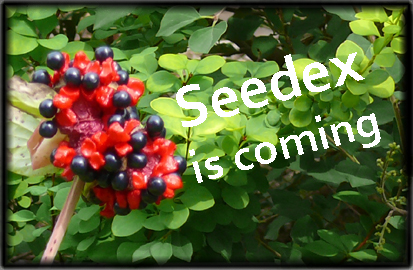
Plant of the Month October 2025
GENERAL INFORMATION: The late Fred Case gave me a plant 20+ years ago. This was a seedling from a plant in his Michigan garden which was grown from wild collected seed. It now grows happily on the fence surrounding our pool. There are many varieties of this versatile Clematis. The Clematis International 2025 lists 37, of varying colours but all the same basic structure.
Common Name: Leatherflower or vasevine, + many more.
Life Cycle: Perennial vine, dying to ground in winter.
Height: Up to 4m.
Bloom Time: in Southern Ontario - June, July, flowering on new stems.
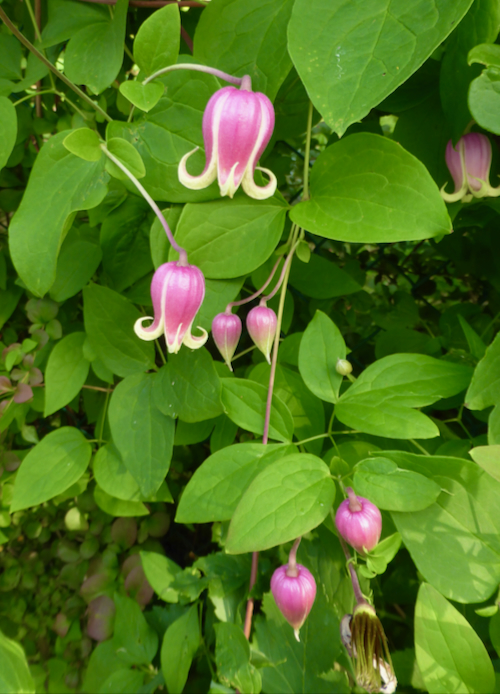
Clematis viorna.
Flower Colour & Size: Single, down facing, urn-shaped bells, approx. 2 cm long, usually reddish in colour with curled, upturned, cream tipped tepals. These are thick, usually 4 in number.
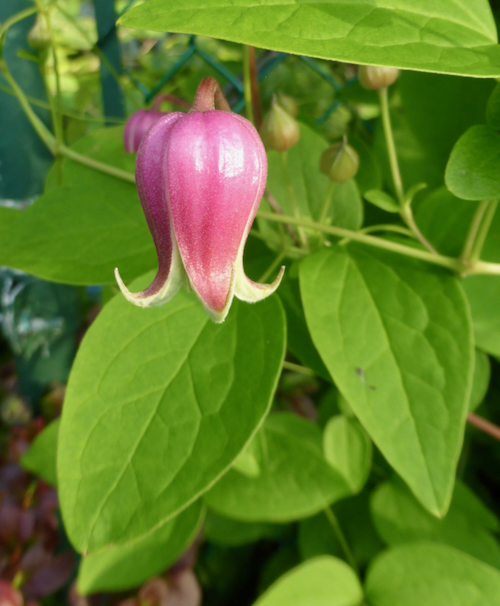
Clematis viorna - close up.
Leaves: Compound pinnate leaves with twinning petioles.
Fruit: The “seeds” are botanically fruit. They are one-seeded achenes, with long feathery tails. In C. viorna, they about 4 cm long, green when immature, ripening to gold and then brown.
Range: South East United States.
Habitat: Open woodlands, stream banks, thickets.
CULTIVATION:
Plant: where there is room to spread.
Light: Part shade to full sun.
Soil: Many soils, including sandy and rocky soils. Must be well drained.
Water: Average.
USDA Hardiness: Zones 4 - 9.
Pests and Diseases: Usually trouble free if well drained.
Companion planting: Other small shrubs or trees as a support.
Pollinators: Butterflies, bees, hummingbirds and other birds.
Pruning: Cut down to ground in early spring. (Pruning Group 3) Be careful not to damage emerging new shoots.
Propagation: By seed, cuttings or layering.
Seedex availability: Often available in various seed exchanges.
Germination Tips: Sow @ 20°C. Seed germinates within 3 months. Will gently self seed in the garden.
Problems: Should be no problems if well drained.
Toxicity: Mouth pain and ulcers if eaten! Leaves and sap are poisonous to cats, dogs and horses.
References:
https://www.gardenia.net › Plants
https://en.wikipedia.org/wiki/Clematis_viorna
https://plants.ces.ncsu.edu/plants/clematis-viorna/
Text and images supplied by Anna Leggatt

Plant of the Month September 2025
GENERAL INFORMATION: I loved the seed heads of “Silver Pennies” or “Honesty” as a child. Later I found the mauve flowers and first year green growth rather boring. Then I discovered the white flowered form with variegated leaves. Yes! Seeds germinated well but the young plants had green leaves! This happened again and I told my friend the seeds were not what I wanted. “Didn’t you know the white appears the 2nd year?” Research your plants! Lunaria is a typical member of the Brassicaceae, the cabbage family.
Common Name: Honesty, Money Plant, Silver Dollar Plant, Silver Pennies.
Life Cycle: Herbaceous biennial.
Height: 60 cm - 1m, with a spread of .5 m.
Bloom Time: May in Southern Ontario.
Flower Colour & Size: White, to 2.5 cm across, with 4 petals in large clusters. (Terminal racemes).
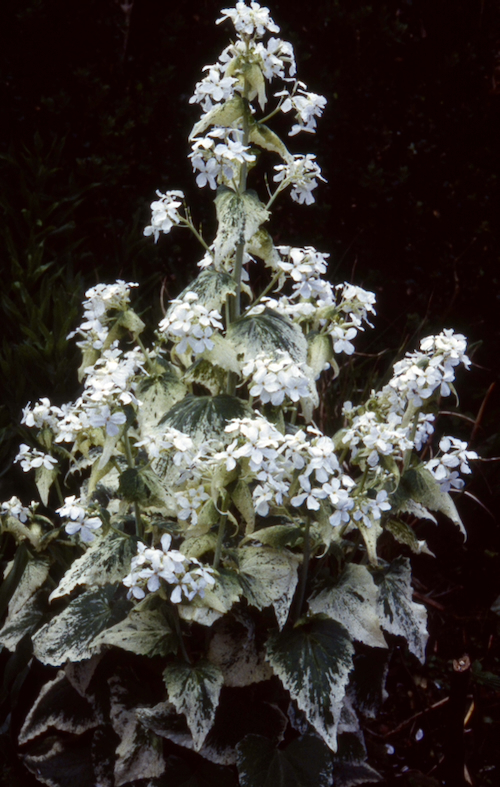
Lunaria annua var albiflora ‘Alba Variegata’ - in flower.
Scent: Floral fragrance.
Leaves: Heart shaped with a white border in 2nd year, varying in width. Serrated margins. 8-12 cm long, 5cm wide.
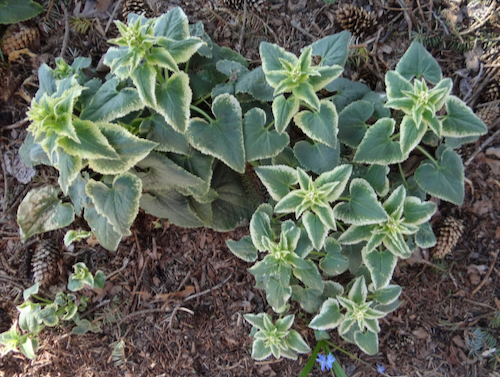
Lunaria annua var albiflora ‘Alba Variegata’ - early 2nd year.
Fruit: “A flat, oblong-elliptic to nearly orbicular silicle with satiny, paper-white septum.” (Hortus 3rd.) 3cm wide.
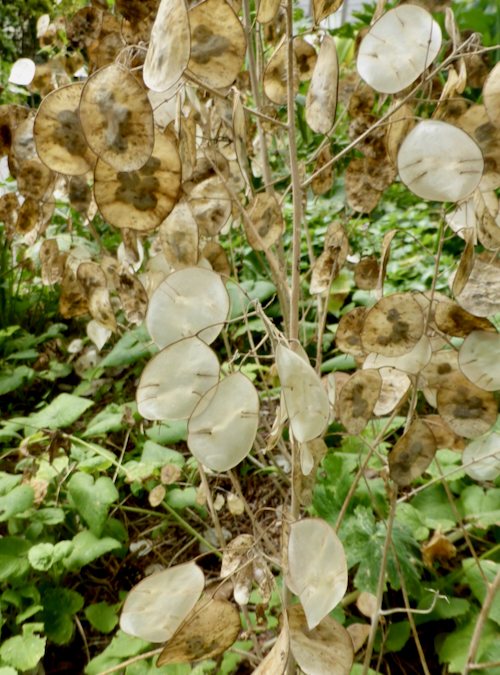
Lunaria annua var albiflora ‘Alba Variegata’ - seeds & "Silver Dollars."
Range: Central and Southern Europe, Western Asia.
Habitat: Woodland edges, disturbed areas.
CULTIVATION:
Plant: In groups or as a specimen.
Light: Full sun to partial shade.
Soil: Most soils, should be well drained and fertile for best growth.
Water: Moderate amounts till the seed pods start to turn brown.
USDA Hardiness: Zones 5-10.
Pests and Diseases: Usually trouble free.
Companion planting: With cottage garden plants in border.
Pollinators: Butterflies and bees.
Propagation: By seed. Collect seeds from plants with the best variegation.
Seedex availability: Often in the ORG&HPS Seedex.
Germination Tips: Self seeds. Collect seeds from plants that had the best variegation. Plant outside or sow @ 20°C. Seed germinates within 3 months. N.B. Usually no leaf variegation 1st year.
Toxicity: Edible - I have never tried it. Cabbage-like, with mustard tasting seeds.
Uses: The seed heads are useful in long-lasting flower arrangements after the seeds are shed.
References:
Wikipedia
https://www.rhs.org.ukhttps://www.rhs.org.uk
https://www.wildfooduk.com/wild-plants/honesty/
https://plants.ces.ncsu.edu/plants/lunaria-annua/
Text and images supplied by Anna Leggatt

Plant of the Month August 2025
GENERAL INFORMATION: There are over 250 species of Aconitum. These are poisonous members of the Buttercup family with a toxin can be absorbed through the skin. A. hemsleyanum climbs by twining stems. My plant came from the late Harry Lumsden. It is not happy after deck renewal and this hot dry Toronto summer.
Common Name: Climbing Monkshood, aconite, monkshood, wolfsbane, leopard's bane, devil's helmet.
Cultivars: Aconitum hemsleyanum ‘Red Wine’.
Life Cycle: Vine. Dies down in winter in Toronto.
Range: Central and Western China.
Habitat: Woodland edges.
Height: 2-3 m.
Bloom Time: August to September in Southern Ontario.

Aconitum hemsleyanum.
Flower Colour & Size: Five petaloid sepals with the upper sepal forming a yellow-green, blue tinged helmet or hood (galea) with blue veining. The true petals are two nectaries within the hood, plus some scales around numerous stamens.

Aconitum hemsleyanum - close up.
Scent: Not noticeable.
Stems: Dark red brown, twining.
Leaves: Mid-dark green, three deeply divided compound pinnate leaflets.

Aconitum hemsleyanum - leaves.
Fruit: Erect follicles 1.5 cm long with several seeds.
CULTIVATION:
Plant: Poisonous. Especially roots and seeds. Position with care. Allow to scramble through other deciduous shrubs.
Light: Full sun to part shade. Avoid hot mid-day sun.
Soil: Most well drained damp soils, preferably with plenty of organic material.
Water: Medium amounts. Must not dry out. Avoid any standing water.
USDA Hardiness: Zones 4-8.
Pests and Diseases: Aphids? Usually pest free.
Companion planting: Yellow Clematis.
Pollinators: Long-tongued bumblebees. May attract hummingbirds.
Propagation: By seed or careful division.
Seedex availability: Sometimes in seed exchanges.
Germination Tips: Poisonous. Handle with care. Plant seed fresh. Otherwise try 20°C x 4 weeks, then -7°C x 6 weeks, then 10°C. Slow.
Sadly, my plant was damaged by deck construction and is probably dead. NB - grow a second plant if difficullt to replace.
References:
Wikipedia.
https://www.rhs.org.uk/plants/46855/aconitum-hemsleyanum/details
Text and images supplied by Anna Leggatt

Plant of the Month July 2025
This is a low-maintenance biennial from the Middle East. Legend has it that Miss Willmott, (Ellen Willmott, 1858-1934) loved the plant and surepticiuosly dropped seeds in appropriate places when she visited gardens. Another Giant Sea Holly, Eryngium pandanifolium, is native to South America.
GENERAL INFORMATION:
Common Name: Miss Wilmots Ghost, Giant Sea Holly, Giant Ornamental Thistle Flower, Tall Eryngo.

Eryngium giganteum, inflorescence.
Cultivars: ‘Silver Ghost’.
Life Cycle: Herbaceous biennial. Most Eryngium sp. are perennial.
Height: 60-100cm, about 100cm wide.
Bloom Time: June to August.
Flower Colour & Size: Tight cone-shaped umbel of small greenish blue flowers with blue anthers, surrounded by silvery, spiky, palmately divided, 7cm bracts.

Eryngium giganteum, with pollinator (Digger wasp, Sphex ichneumoneus).
Leaves: A basal evergreen rosette of 15cm long, heart shaped green leaves, forms during the first year. The leaves wither as the flower stalk appears

Eryngium giganteum leaf.
Range: Native to Turkey, Caucuses, Iran.
Habitat: Tall grass prairies and dry, well-drained soils.
CULTIVATION:
Plant: in a suitable place when small. The tap-rooted plant resents disturbance.
Light: Full sun.
Soil: Most soils - prefers moist, well drained fertile soil.
Water: Medium. Drought tolerant.
USDA Hardiness: Zones 4-7.
Companion planting: Other sun loving perennials.
Problems: Nothing serious.

Eryngium giganteum, maturing seed (fruit) heads.
Propagation: Will self-seed. Sow @ 20°C for 6 weeks, then 4°C for 6 weeks, slowly raise temperature to 10°C for 6 weeks. If there is no germination, repeat the cycle.

Eryngium giganteum, seed dispersal.
Pollinators: Bees, butterflies, hover flies.
References:
https://www.missouribotanicalgarden.org/PlantFinder
https://onrockgarden.com/index.php/germination-guide
Text and images supplied by Anna Leggatt (Toronto Master Gardener)

Plant of the Month June 2025
GENERAL INFORMATION: A keen gardener started our garden when the house was built, about 1950. Perhaps 10 of her species still exist. She would not recognize anything, except the Weigela ‘Florida Variegata’ beside the north-facing front door. It must be over 60 years old, double the projected life span. It is still healthy, though not growing as vigorously. Its companion dwindled, probably through age and root competition.
Synonym: Weigela florida ‘Aureovariegata’, Weigela florida ‘Variegata’, Weigela florida 'Variegata Aurea’, Weigela florida 'Nana Variegata'
Common Name: Weigela.

Weigela 'Florida Variegata’ 60 year-old shrub.
Life Cycle: Deciduous shrub.
Height: About 1.5 m tall and wide.
Bloom Time: June in Toronto.
 Weigela 'Florida Variegata’ - flowers.
Weigela 'Florida Variegata’ - flowers.
Flower Colour & Size: Clusters of funnel shaped, pale to dark pink flowers, about 3 cm long.
Leaves: Opposite, acuminate, green leaves grow on arching stems. The greenish white margin becomes yellowish white in the summer.

Weigela 'Florida Variegata’ -flowers and leaves.
Range: Native to North China, Japan and Korea.
Habitat: Clearings in mixed forests, scrub.
CULTIVATION:
Light: Sun or partial shade.
Soil: Most soils, including clay – well drained, fertile. Somewhat tolerant of slightly salty soils.
Water: Average to low.
USDA Hardiness: Zones 5-9.
Pest and Diseases: Usually trouble free.
Attracts: Hummingbirds.
Companion planting: Other shrubs in a shrub border, or foundation planting, or as a specimen.
Pruning: Remove older stems after flowering.
Propagation: By cuttings – softwood in the spring; semi hardwood in the summer and hardwood in the fall or early winter. Any seed is unlikely to produce a similar plant.
References:
https://www.missouribotanicalgarden.org/PlantFinder
https://www.rhs.org.uk/plants/93517/weigela-florida-variegata-(v)/details
https://plants.vandermeernursery.com/11110008/Plant/8313/Dwarf_Variegated_Weigela
Text and images supplied by Anna Leggatt (Toronto Master Gardener)

